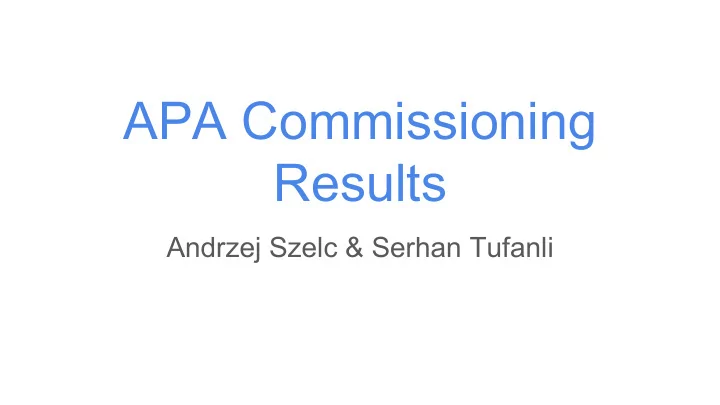

APA Commissioning Results Andrzej Szelc & Serhan Tufanli
Introduction ● What we measured ○ Side A ○ Side B ● Notes/Observations on method(s) ○ What we can and cannot measure ○ Comparison + Calibration ● Measurements on Side A ○ First observations + Rechecks ● Measurements on Side B ○ Selection of wires + results ● Conclusions 2
What we measured: Side A ● Measured 112 wires in total ( 43 G-plane, 14 X-plane, 27 V-plane, 28 U plane). ● First measurements to see how quick we can do the tension measurements. ● After first look at data, did a few extra cross-checks. ○ Measured a few G-plane wires in region 2. ● *Did not* pay much attention to mapping or selecting outliers - focus on understanding the system and method. 3
What we measured: Side B Region 1 ● 188 Total wires (69 in plane G, 51 in plane U, 37 in plane V, 31 in plane X). ● Relatively thorough measurement - measure wires around board boundaries (G-Plane) + selected outliers. ○ Result is a sample of random wires and outliers. ● Came up with list prepared but improvised in regions. ○ Much faster to do adjacent wires than search for a single wire according to mapping. ● Paid attention to mapping (as much as possible). ● Limited to Region 1. 4
Observations/notes on method(s) ● We used the laser tensioning device in two modes: ○ Connected to a guitar amplifier + tuner app on smartphone (consistent with method used at PSL) ○ Connected to laptop with LabView DAQ: calculates FFT and selects peaks, calibrated at Manchester . ● Amplifier + Tuner is really helpful in figuring out the mapping. 5
Tuner vs LabView cross-calibration ● Plot of tension of same wires between labview and the tuner. ● LabView setup has been calibrated in MCR, see difference of O(1Hz) around 60 Hz (in tune with our observations) Estimated error of our measurement is O(1Hz), which means max 3% (depending wire length) systematics in tension of wires. 6
Observations/notes on methods and APA geometry constraints ● Mapping G and X wire plane wires is almost impossible outside of regions 1 and 5. ● In each region there are 2 possible placements of tensioning bar. ● In region 5, lowest and middle positions are not usable due to bolts tethering the APA to ground. ● In region 1 the middle (and top?) position is not usable due to absence of M1 holes. ● Due to APA geometry, a set of wires in U and V planes are not possible to test (short wires). 7
First Measurements on Side A (plane X) ● All wires measured were in the higher half of spectrum. ● “Wire-by-wire” comparison indicates a systematic shift of 10% (note that mapping might not be exactly precise) 8
First Measurements on Side A (plane V) ● Tension looks visibly shifted down. “Wire-by-wire” comparison suggests a drop of 10-15% in tension.* * Note that here mapping here is not precise for all wires. Although, in these cases, the wires are same length, so general tension comments apply in region. 9
First Measurements on Side A (plane U) ● U-Plane wires seem to be in the right ball park. ● Wire-by-wire comparison seems to show a small rise in tension (0-10%). ○ Mapping not perfect, so side B should be more precise. 10
First Measurements on Side A (plane G) ● G-Plane tension seems systematically higher (15-20%). 11
Additional measurements on Side A (plane G, Region 2) ● Region 2 seems to be less over-tensioned than Region 1 ○ (small sample size, though) 12
Measurement on Side B - Plane X ● 31 wires were measured ○ Outlier wires: ■ Mean Tension-2.5*RMS > tension of the wire OR MeanTension+2.5*RMS < tension of the wire OR ■ Tension of the wire > 5.3N ○ Random wires from the end and beginning of boards ● Tension is 7% higher than the PSL measurements with 5% RMS 13
Measurement on Side B - Plane V ● 37 wires were measured ○ Outlier wires: ■ Mean Tension-2.5*RMS > tension of the wire OR Mean Tension+2.5*RMS < tension of the wire OR ■ Tension of the wire <4N OR tension of the wire>5.9N AND ■ Wirelength>600 ○ Random wires from the end and beginning of boards ● Tension is 14% less than the PSL measurements with 2% RMS 14
Measurement on Side B - Plane U ● 45 wires were measured ○ Outlier wires: ■ Mean Tension-2.5*RMS > tension of the wire OR Mean Tension+2.5*RMS < tension of the wire OR ■ Tension of the wire <4N OR tension of the wire>6N AND ■ Wirelength>600 ○ Random wires from the end and beginning of boards ● Tension is 5% more than the PSL measurements with ~1% RMS 15
Measurement on Side B - Plane G ● 69 wires were measured ○ Outlier wires: ■ Mean Tension-2.5*RMS > tension of the wire OR MeanTension+2.5*RMS < tension of the wire OR ■ Tension of the wire > 5.5N ○ Random wires from the end and beginning of boards ● Tension is 15% higher than the PSL measurements with 2% RMS 16
Possible reasons for the measured difference ● Different APA orientation during the tension measurements ○ Horizontal at PSL ○ Vertical at CERN ● Systematics due to hardware and measurement method ○ Hardware: Different amplification hardware between PSL and CERN 17 ○ Method: Constraining wires with clips on combs
Conclusions ● We re-measured the tension of 300 wires at CERN ● We observed ○ 7% increase in tension for X layer wires ○ 14% decrease in tension of the V layer wires ○ 5% increase in the tension of the U layer wires ○ 15% increase in the tension of G layer wires ● APA orientation during the tension measurements might be the biggest reason ○ Detailed FEA analysis and engineering is needed if we would like to understand all the details 18
Recommend
More recommend